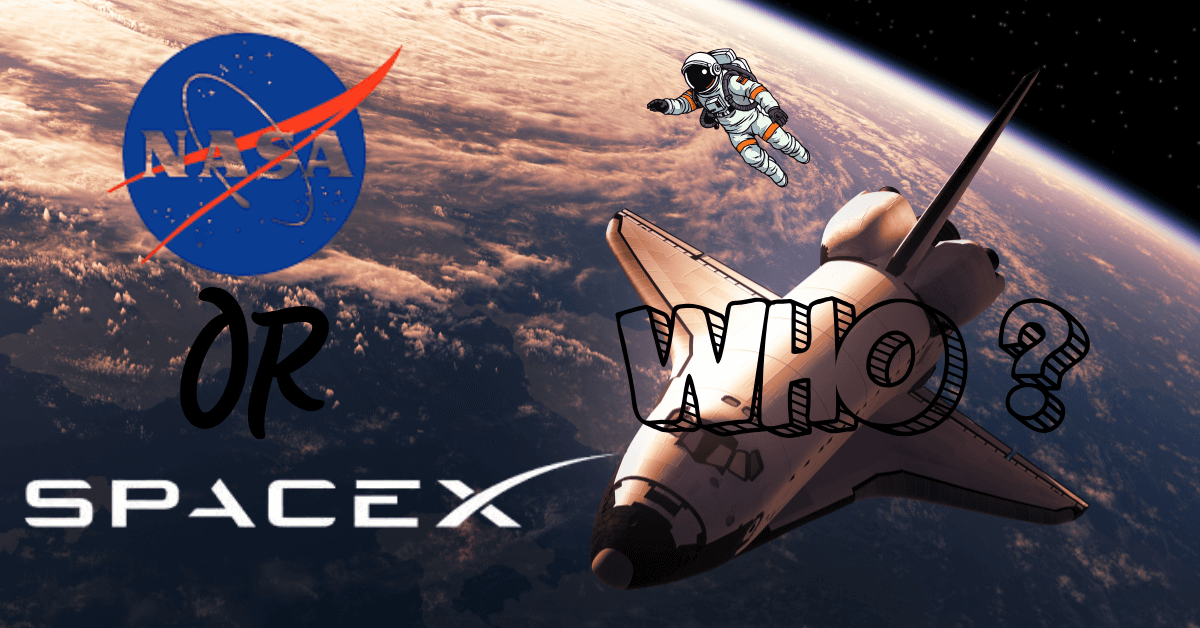Space exploration has entered an exciting era where the debate over NASA or SpaceX often dominates conversations about humanity’s journey to the stars. On one side, NASA represents decades of government-funded missions, scientific achievements, and international collaborations. On the other side, SpaceX embodies the speed, innovation, and bold ambition of the private sector. Together, they have reshaped how we think about rockets, spacecraft, and our path to the Moon and Mars.

The Legacy of NASA in Space Exploration
NASA, founded in 1958, is synonymous with iconic missions that changed human history. The Apollo program landed astronauts on the Moon, while the Space Shuttle ushered in a new era of reusable spacecraft long before the commercial space race began. Beyond human spaceflight, NASA has launched satellites like the Hubble Space Telescope and planetary probes such as Voyager, Cassini, and Perseverance on Mars.
The agency’s role has always extended beyond exploration. It is deeply involved in Earth science, climate monitoring, and international partnerships through projects like the International Space Station. As a publicly funded organization, NASA emphasizes safety, reliability, and scientific return over rapid iteration. This approach sometimes leads to higher costs and longer timelines, but it ensures missions are held to the highest regulatory and safety standards.
The Rise of SpaceX and the Private Space Race
Founded by Elon Musk in 2002, SpaceX has redefined how quickly a company can innovate in aerospace. The company’s most celebrated achievement is the Falcon 9 rocket, designed for reusability, which significantly reduced the cost of access to space. Landing boosters that were once discarded into the ocean has not only saved billions of dollars but also proven that private companies can match, and in some cases outperform, traditional government contractors.
SpaceX’s Dragon spacecraft has ferried astronauts to the International Space Station under NASA’s Commercial Crew Program. The ambitious Starship project, currently under development, promises a fully reusable heavy-lift rocket capable of transporting cargo and people to the Moon and eventually Mars. By moving fast and taking risks, SpaceX pushes the boundaries of what’s possible in modern rocketry.

Comparing Budgets, Costs, and Efficiency
A major difference between these two giants lies in funding. NASA operates on an annual budget of around $25 billion, determined by Congress, and is often subject to political shifts. Cost overruns and delays are frequent because large programs like the Artemis lunar initiative or the Space Launch System (SLS) involve multiple contractors and extensive testing.
By contrast, SpaceX leverages private investment, commercial contracts, and revenues from ventures such as Starlink satellite internet. Its streamlined structure allows faster prototyping and testing. For example, while NASA’s SLS has faced delays for years, SpaceX has already launched and iterated on multiple prototypes of Starship within a much shorter timeline.
This cost and speed advantage doesn’t necessarily mean SpaceX replaces NASA—it highlights how the private sector can complement government space programs.
Human Spaceflight: Safety vs Agility
When it comes to sending people beyond Earth, safety is non-negotiable. NASA’s decades of experience with human spaceflight ensure rigorous procedures, detailed risk assessments, and oversight. From Mercury to Apollo and Shuttle missions, NASA has built an unmatched foundation in astronaut training and mission planning.
SpaceX, however, has quickly built credibility with its Crew Dragon missions to the ISS. These flights, certified by NASA, demonstrated that a private company could safely launch astronauts—a milestone that many believed was decades away. Yet SpaceX’s rapid testing approach, while efficient, sometimes raises concerns about safety margins, especially with experimental projects like Starship.
Rockets and Spacecraft: SLS vs Starship
The comparison between NASA’s Space Launch System and SpaceX’s Starship illustrates their contrasting approaches.
- SLS: Built for Artemis missions, this government-backed rocket is powerful but extremely costly, with each launch running into billions of dollars. Its design relies heavily on traditional contractors such as Boeing and Lockheed Martin.
- Starship: Designed as a fully reusable launch system, it aims for rapid turnaround and massive payload capacity. If successful, it could drastically lower the cost of interplanetary travel, making Mars colonization more feasible.
Both rockets represent humanity’s ambitions, but while SLS embodies reliability and government oversight, Starship symbolizes risk-taking and innovation.

Collaboration Instead of Competition
Although debates often frame NASA and SpaceX as rivals, the truth is more complex. NASA contracts SpaceX for cargo and crew transport to the ISS, and SpaceX supports NASA’s Artemis program with lunar lander designs. In many cases, government agencies rely on private companies to supply innovation, while the private sector depends on NASA’s experience and regulatory framework to ensure safety and credibility.
This collaboration reflects a new model of space exploration where government and private industry work hand-in-hand. Instead of competition, it’s more accurate to see them as partners with overlapping but distinct missions.zz
The Bigger Picture: Society, Science, and the Future
NASA’s contributions extend far beyond rockets. Its climate monitoring satellites track global warming, while research in microgravity aboard the ISS benefits medicine, materials science, and technology development. Public benefit remains its central mission.
SpaceX, meanwhile, is reshaping global connectivity with Starlink, providing satellite internet to underserved regions. While not purely scientific, this innovation demonstrates how private space ventures can impact daily life on Earth.
Looking ahead, humanity’s expansion to the Moon and Mars will likely require both NASA’s expertise and SpaceX’s agility. NASA brings credibility, funding stability, and scientific rigor. SpaceX adds speed, cost reduction, and disruptive technology. Together, they form the dual engines driving humanity into a new space age.
FAQs
What is the difference between NASA and SpaceX?
NASA is a U.S. government agency focused on science, exploration, and public missions, while SpaceX is a private company that emphasizes innovation, reusability, and cost reduction.
Which is more innovative: NASA or SpaceX?
SpaceX is often seen as more agile in developing reusable rockets and pushing rapid innovation, while NASA provides scientific breakthroughs and long-term research.
How do launch costs compare between NASA and SpaceX?
SpaceX significantly reduces launch costs through reusability, whereas NASA’s government-funded systems like SLS are more expensive due to complexity and oversight.
Who will reach Mars first, NASA or SpaceX?
SpaceX aims for Mars with its Starship project, but NASA’s deep space missions and partnerships mean both may play critical roles in humanity’s journey.
Do NASA and SpaceX work together?
Yes, they collaborate through programs like Commercial Crew and Artemis, where SpaceX provides transport while NASA handles mission planning and scientific goals.
Conclusion
The debate between NASA and SpaceX is less about rivalry and more about synergy. NASA provides decades of expertise, safety standards, and global collaboration, while SpaceX delivers speed, cost-effective rockets, and daring visions of interplanetary travel. The future of exploration will not depend on choosing one over the other, but on how both can complement each other to push humanity further into space than ever before.
Liam is a freelance writer, blogger, and digital media journalist. He has a management degree in Supply Chain & Operations Management and Marketing and boasts a wide-ranging background in digital media.











